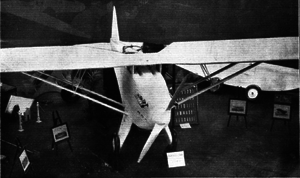Aviméta 88
| Aviméta 88 | |
|---|---|
 | |
| Role | Two seat reconnaissance fighter |
| National origin | France |
| Manufacturer | Aviméta (Société pour la Construction d'Avions Métallique) |
| Designer | George Lapère |
| First flight | c.1927 |
| Number built | 1 |
|
| |
The Aviméta 88 was an all-metal French two-seat reconnaissance-fighter or heavy fighter tested in 1927.
Design and development
Aviméta, (Société pour la Construction d'Avions Métallique)‚ grew out of the Aeronautical Department of the Schneider-Creusot arms manufacturer.[1] Both the frame and the corrugated covering of the Aviméta 88 were made from Alferium, an aluminium-iron alloy developed by Schneiders.[1]
It was a parasol aircraft, with wings of constant chord and with slightly pointed, semi-elliptical tips. The thin-airfoil-section wings were built around two lattice girder spars and had a skin thickness of 300 μm. There was a large, trapezoidal cut-out in the trailing edge to improve the view from the cockpits. Its aileron hinges were set at a shallow angle to the trailing edge.[2]
The wings were braced to the fuselage with a parallel pair of struts from the lower longerons to the spars at about mid-span assisted by N-form, cross-braced jury struts at right angles. Four very short struts from the upper fuselage longerons to the wing centre section formed a low cabane.[2][3]
The square-section, rounded-cornered fuselage was built around these four longerons and a set of diagonally braced formers.[1] The Aviméta's 444 kW (595 hp) Hispano-Suiza 12Hb water-cooled V-12 engine[4] was in a pointed nose, driving a two-blade propeller. There were two open cockpits, with the pilot forward at mid-chord and the gunner/observer behind in line with the trailing edge. Behind the cockpits the fuselage tapered rapidly in profile to a conventional empennage, with the tailplane mounted at mid-fuselage. Both horizontal and vertical surfaces were strongly tapered, particularly on the leading edges, with a broad tailplane and fin but with small, inset elevators and rudder.[1][2] The Aviméta 88 had independent bungee-sprung wheels on legs enclosed in tapered trouser fairings attached to the lower longerons at the bottom of the wing struts.[2][3]
The Aviméta 88 was on show at the December 1926 Paris Aero Salon.[1] It may not have flown by that date, and rather little is known about its later history, though it gave a "pretty impressive" display at Villacoublay in September 1927.[5] Development was terminated when the official call for a two-seat fighter-reconnaissance aircraft was rescinded.[4]
Specifications
Data from Flight (2 December 1926)[1]
General characteristics
- Crew: two
- Length: 9.76 m (32 ft 0 in)
- Wingspan: 17.00 m (55 ft 9 in)
- Height: 3.55 m (11 ft 8 in)
- Wing area: 40 m2 (430 sq ft)
- Empty weight: 1,550 kg (3,417 lb)
- Gross weight: 2,400 kg (5,291 lb)
- Fuel capacity: 310 kg (680 lb) (420 l (92 imp gal; 110 US gal)) in crash proof and in-flight jettisonable tank
- Powerplant: 1 × Hispano-Suiza 12Hb[4] water-cooled V-12, 444 kW (595 hp)
- Propellers: 2-bladed
Performance
- Maximum speed: 240 km/h (149 mph; 130 kn) at sea level, 220 km/h (140 mph) at 5,000 m (16,000 ft)
- Service ceiling: 7,500 m (24,606 ft)
- Time to altitude: 16 min to 5,000 m (16,000 ft)
Armament
- two fixed, synchronised 7.7 mm (0.303 in) Vickers machine guns firing through propeller disc[4] and two more mounted on the wing.
- pair of Lewis guns[4] on flexible mounting in rear cockpit.
References
- 1 2 3 4 5 6 "Avimeta". Flight. XVIII (48): 776. 2 December 1926.
- 1 2 3 4 "L'Aviméta AVM-88". L'Aéronautique. 8 (91): 402. December 1926.
- 1 2 "Avimeta". Flight. XVIII (50): 825–7. 16 December 1926.
- 1 2 3 4 5 Green, William; Swanborough, Gordon (1994). The Complete Book of Fighters. Godalming, UK: Salamander Books. pp. 44–5. ISBN 1-85833-777-1.
- ↑ "L'Aviation Francaise et l'American Legion". Les Ailes. 7 (328): 1. 29 September 1927.